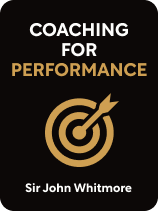

This article is an excerpt from the Shortform book guide to "Coaching for Performance" by Sir John Whitmore. Shortform has the world's best summaries and analyses of books you should be reading.
Like this article? Sign up for a free trial here.
Want to know how to empower employees as a leader? What are some of the methods that experts recommend?
In Coaching for Performance, Sir John Whitmore explains three ways to empower employees as a leader, claiming that using these methods will allow your employees to flourish and reach their full potential. His approach to empowering employees is strengths-based and non-judgemental.
Read on to learn how to empower employees as a leader, according to Whitmore’s three methods.
Empowering Employees as a Leader
In Coaching for Performance, Sir John Whitmore explains how to empower employees as a leader, arguing that you must nurture three qualities to bring out your employees’ full potential. These qualities are self-confidence, awareness of self and others, and ownership of their work. In this article, we’ll explain how to empower your employees by nurturing these qualities as a leader, based on the advice in Coaching for Performance.
(Shortform note: In Turn the Ship Around, L. David Marquet argues that for workers to perform at their peak, leaders need to not just empower but free them to apply their talents, energy, and creativity—which ultimately endows them with a sense of internal power.)
#1: Build Self-Confidence
Whitmore says that one of the best ways to empower employees as a leader is to foster their self-confidence. He claims that coaching naturally cultivates a positive cycle of self-belief in the following way: Employees set and achieve small goals in pursuit of a larger end goal, creating a series of successes that they attribute to their efforts. This builds their confidence in what they’re doing and encourages them to continue forward on a positive path.
Further, these successes make employees feel they have coaches’ trust and respect. This strengthens their sense that they’re able to make good decisions on their own and encourages them to continue to take ownership of their actions and work.
(Shortform note: In Lean In, Sheryl Sandberg says that lack of confidence harms women pursuing leadership paths. Many experience “imposter syndrome,” which makes them feel undeserving and constantly on the verge of being exposed as frauds. Women are more likely than men to attribute their success to luck and to internalize negative feedback, lowering their self-confidence. To shake imposter syndrome, women should acknowledge that it’s a distortion of reality, “fake it till they make it,” and seize opportunities rather than wait for them.)
#2: Build Attunement to Self and Others
As a leader, another way to empower employees is to help them become attuned to—or aware of—their own and others’ feelings and situations. Self-attunement helps your employee consider their emotions and biases so they can make conscious decisions about how to act—and avoid reacting—in the heat of the moment. This self-regulation supports their ability to act in ways that foster healthy working relationships, says Whitmore.
For example, say your partner calls you at work and yells that you left dishes in the sink. When you get off the call, you’re aware that you’re furious and likely to snap at the next person you see. But you know that lashing out at colleagues would damage your working relationships, so you take a deep breath, acknowledge that you’re irritated, and take a walk to clear your head.
(Shortform note: Psychologists agree that practicing awareness can make you less reactive in the moment and better able to manage situations. Further, when you regularly engage your awareness when you’re fearful or anxious, you can reprogram your brain for the better. So, if your mind is racing, focus on a single sense—like how something tastes or smells—to dampen the release of stress hormones. Also, be aware of deeply embedded, cognitive distortions that mess with your mind and well-being. For example, look for thoughts about what you “should” do (the root of perfectionism) and replace them with rational thoughts.)
Additionally, attunement to others’ emotions and circumstances enables your employee to gather information about conditions that impact their colleagues and their work together, which further improves their performance.
For example, if you’re aware that a particular client annoys your boss, and that client comes to meet with your boss on a day you’d planned to pitch an idea to them, you’ll know to wait to pitch that idea until the next day when your boss may be in a better mood and more receptive to it.
(Shortform note: While there’s value in being aware of others’ emotions and situations, some coaches say there are times when you should ignore others—like when they’re struggling. For example, you may be inclined to rescue a colleague buried in work, but people often learn the most when they go through a struggle and come out the other side on their own. So, rather than rush in, be peripherally aware of their situation and jump in only if they truly need it.)
Whitmore recommends developing awareness of self and others through meditation.
(Shortform note: Whitmore doesn’t explain in detail how to meditate. To do a sitting meditation, follow these steps: 1) Sit in a chair with your feet flat on the floor, hands in your lap. 2) Notice your breath flowing in and out of your nose. 3) If thoughts or physical sensations arise, mentally note them, then draw your attention back to your breath.)
#3: Build Accountability and Ownership
Whitmore says that, as a leader, you can help employees develop an accountability and ownership mindset to empower them and increase their commitment to their work. When workers feel they have ownership of their goals and can decide the best way to accomplish them, they’re motivated to do their best, which improves their performance.
To build your employee’s sense of accountability and ownership, follow these three tips to ask engaging questions that allow you to gather information about what’s important to them:
Tip 1: Ask open-ended questions. Open-ended questions yield more candid, detailed answers than yes or no questions, which typically prompt one-word answers and shut conversations down.
Tip 2: Use non-judgmental words. Use non-critical language to cultivate trust, create a safe space for your employee to open up, signal interest, and gather information. Words that foster positive engagement include, “What?” “When?” “Who?” and “How many?” For example, “What are your thoughts on this issue?” and “When do you think is a good time to take action on this?”
Tip 3: Follow broad questions with detailed questions to pursue your employee’s interests. Once you have a big-picture understanding of what your employee is saying, ask more in-depth questions to prompt them to think more deeply about what matters to them. The more they talk about things they care about, the more engaged they’ll be in the coaching process, and the more interested they’ll be in taking ownership of their work.

———End of Preview———
Like what you just read? Read the rest of the world's best book summary and analysis of Sir John Whitmore's "Coaching for Performance" at Shortform.
Here's what you'll find in our full Coaching for Performance summary:
- A guide on the ins and outs of performance coaching
- Strategies to maximize employees’ potential and performance
- How to measure organizational culture and the impact of your work






